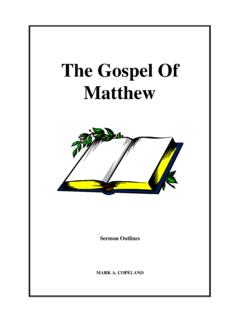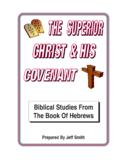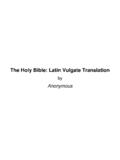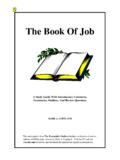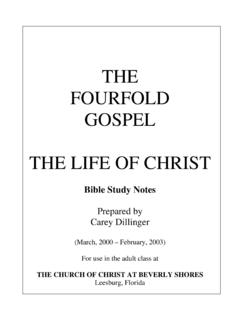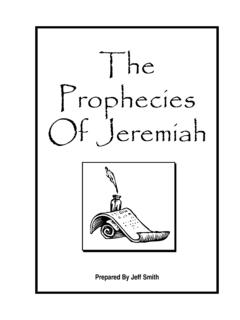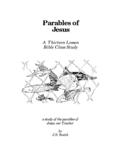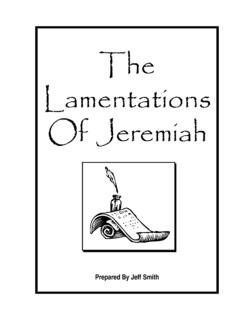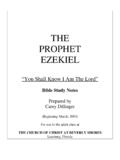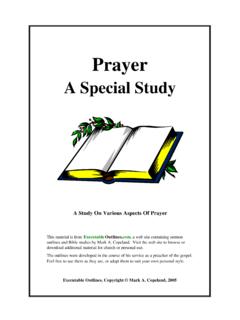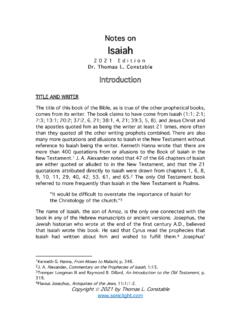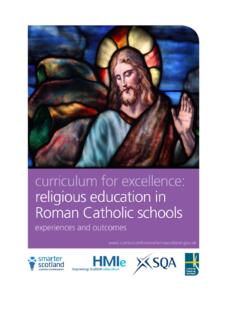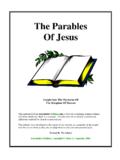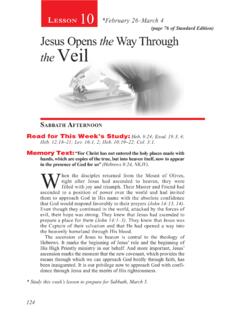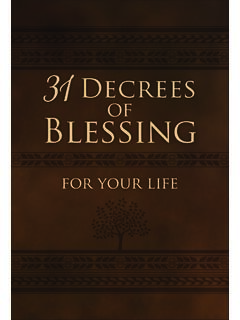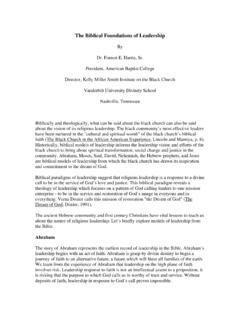Transcription of The Prophet Isaiah - Bible Study Guide
1 Jeff Asher 2001 The Prophet Isaiah A Study of the prophecy of Isaiah , the son of Amoz who prophesied during the days of Uzziah, Jotham, Ahaz and Hezekiah, kings of Judah. This great Prophet was called of God in his youth to cry aloud and spare not. His willing answer was, Here am I send me. For nearly sixty years he proclaimed the will of the Holy One of Israel to a sinful nation, laden with iniquity. His was a message of repentance, retribution and restoration. This beautiful book that announces the coming Messiah and His eternal kingdom in sixty-six chapters is studied in twenty-six lessons. Emphasis is given to the historical background of the book and the prophetic announcements of the coming Christ, the Lord of Glory. Ancient Tower and Vineyard ( Isaiah 5:1-10) 1 The Prophet Isaiah Introduction Isaiah has been called the dean of Old Testament prophets. His book is referred to as the Bible in miniature. There is no denying the beauty, grandeur, passion and pathos of this book.
2 It presents to us the prophetic announcement of God s retribution upon a rebellious and gainsaying people and the promise of His grace and mercy to the faithful remnant that will emerge from those troublesome times. Salvation is of the Lord, is the meaning of the Prophet s name, and it is the message of this book. The great announcement that Isaiah brings to his people is that Jesus is coming! Your Study of this book will broaden both your understanding of Old Testament history and your appreciation of Israel s place in the redemptive scheme of the Holy One of Israel. In it you will see Christ as the Lamb of God that takes away the sins of the world (John 1:29). He is the Suffering Servant of Jehovah upon whom the iniquities of Israel are laid. He is the Great Redeemer of the children of Abraham whom God will highly exalt. Preparation for the Study In order to get the most out of this Study , it is recommended that the student begin by reading the entire book through at least once, if not twice, before proceeding with the individual lesson studies.
3 This will help you get a feel for the book as a whole. Following this page is an analytical chart designed to give an over all picture of the book s organization and theme. There is also an outline of the book which will be followed in the class meeting in discussing the book. The student may want to have the aid of a commentary when preparing for class. For a brief treatment of the book, I recommend Wayne Jackson s book, Isaiah : God s Prophet of Doom and Deliverance (Quality Publications). For a fuller treatment of the text consider Homer Hailey s A Commentary on Isaiah with Emphasis on the Messianic Hope (Religious Supply). There are other commentaries available. Most notable among them is the three volume set by Edward J. Young and a similar work by Paul T. Butler. Another aid that may prove useful is Robert Harkrider s workbook commentary on Isaiah , Trust in the Holy One of Israel (Norris Book Company). The book is about 150 pages and provides a critical outline of the book.
4 I have found it to be very useful in my studies of the book. However, the student will find his own efforts to be the most helpful in understanding the message of this great Prophet of God. Class Participation Attendance of the class meetings is very important. There you will have your own studies enhanced with the understanding of others. Questions you have a bout difficult portions of the book will be answered and additional materials not available in this Study Guide will be provided through audio-visual presentations and handouts. In order to get the most out of the book while giving the most to others your attendance at class meetings is essential. 2 The Prophet Isaiah I. JUDGMENT FROM GOD (1-39) A. Prophecies concerning Judah and Jerusalem (1-12) 1. Isaiah and his time (1:1) 2. Judah s rebellion and coming punishment (1:2-31) 3. The Glorious Messianic Age (2:1-4) 4. Judah s present wickedness (2:5-11) 5. A day of reckoning to come (2:12-22) 6.
5 Judah s punishment and glory (3:1-4:6) 7. Judah s sins (5:1-30) 8. Isaiah s vision and commission (6:1-13) 9. War against Jerusalem (7:1-9) 10. The Lord s sign - Messiah (7:10-16) 11. Judah s coming desolation (7:17-25) 12. The Assyrian invasion (8:1-10:34) 13. Judah s hope in the coming Christ (11:1-12:6) B. Prophecies concerning foreign nations (13-23) 1. Babylon (13:1-14:27) 2. Philistia (14:28-32) 3. Moab (15:1-16:14) 4. Damascus and Israel (17:1-14) 5. Ethiopia (18:1-7) 6. Egypt (19:1-20:6) 7. Babylon (21:1-10) 8. Edom and Arabia (21:11-17) 9. An oracle concerning Jerusalem (22:1-2 5) 10. Tyre and Sidon (23:1-18) C. Judgments upon the nations (24-27) 1. Judgment - the consequence of sin (24:1-23) 32. Jehovah will deliver Zion (25:1-12) 3. Judah s consolation (26:1-21) 4. Evil punished/good rewarded (27:1-13) D. Book of woes (28-35) 1. Woe to Israel (28:1-13) 2. Woe to Judah (28:14-29) 3. Woe to Ariel [Jerusalem] (29:1-24) 4. Woe to those seeking Egypt s aid (30:1-31:9) 5.
6 Salvation to come (32:1-33:24) 6. Wrath to nations/Zion s future (34:1-35:10) E. A historical section (36-39) 1. The Assyrian invasion (36-37) a. Sennacherib s boast (36:1-22) b. Isaiah s response (37:1-7) c. A threat and a prayer (37:8-20) d. God s decree concerning Sennacherib (37:21-38) 2. Hezekiah s deliverance (38) 3. Babylonian Captivity foretold (39) II. COMFORT FROM GOD (40-66) A. Deliverance from Babylonian Captivity (40-48) 1. The greatness of God (40:1-31) 2. The Lord s challenge to heathenism (41:1-29) 3. Promises concerning God s servant (42:1-25) 4. Judah s redemption from captivity (43:1-28) 5. The futility of idolatry (44:1-23) 6. Cyrus the deliverer (44:24-45:13) 7. Jehovah s power over the nations (45:14-25) 8. Idols versus the true God (46:1-13) 9. The impending fall of Babylon (47:1-15) 10. Deliverance from captivity (48:1-22) 4B. Jehovah s Suffering Servant (49-57) 1. Scope of the servant s ministry (49:1-6) 2. The joyful return (49:7-13) 3.
7 Spiritual restoration of Zion (49:14-26) 4. Jehovah s faithful servant (50:1-11) 5. Israel exhorted to trust God (51:1-23) 6. Israel admonished to repent (52:1-12) 7. The servant s suffering/victory (52:13-53:12) 8. Blessings of the new Zion (54:1-17) 9. Extension of Jehovah s mercy (55:1-13) 10. Universal blessings to obedient (56:1-8) 11. Rebuke of corrupt leaders (56:9-57:21) C. The glory of the Messianic Age (58-66) 1. Contrast between true/false worship (58:1-14) 2. The effect of sin (59:1-8) 3. Confession of national wickedness (59:9-21) 4. The glory of the redeemed (60:1-22) 5. The Jubilee of God s favor (61:1-11) 6. Glory of spiritual Zion (62:1-12) 7. Punishment of the nations (63:1-6) 8. Lessons from history (63:7-14) 9. A prayer for victory (63:15-64:12) 10. Destiny of good and bad (65:1-25) 11. A final rebuke (66:1-9) 12. Spiritual Zion s glorious future (66:10-24) 5 6 The Prophet Isaiah Lesson One: Introduction to the Book of Isaiah Lesson Aim: Consider the historical background of The Book of Isaiah in order to better understand its author and message.
8 Lesson Texts: Isaiah 1:1; 6:1; 7:1; 36:1-39:8 Background Texts: 2 Kings 15:1-21:18 and 2 Chronicles 26:1-33:20 Questions for Class Discussion 1. Who is the author of this book? 2. What does his name mean and why is this significant? 3. Tell us what you can about the author of this book? 4. During what period of Judah s history was this book written? 5. What political, economic and spiritual conditions were prevailing in Judah at this time? 6. From your reading of the book, what did you learn of the character of its author? 7. What specific issues does the author address in his book? 8. What is the author s view or perception of the God of Israel? 9. What is Isaiah s attitude toward Judah and Israel? 10. What is Isaiah s attitude toward the nations, that is, the Gentiles? Summary Summarize the message of the Book of Isaiah . 7 The Prophet Isaiah Lesson Two: Jehovah s Complaint Against Judah and Jerusalem Lesson Aim: Consider Jehovah s indictment of the nation for their sins and his earnest call for their repentance and reconciliation.
9 Lesson Text: Isaiah 1:2-2:22 Background Texts: 2 Kings 15:4,35; 16:2-18; 2 Chronicles 27:2; 28:1-5 Questions for Class Discussion 1. Unto whom does Isaiah give commandment to hear? (1:1) What is the significance of this appeal? 2. What two figures does Isaiah use to describe the sinful and rebellious character of Israel? (vv. 2,3) 3. What was the result of Israel s rebellion? (v. 4) 4. What is the significance of the question: Why should ye be stricken any more? ( ) 5. What does the image of the wounded man signify? (v. 6) 6. What is the ultimate consequence with which God threatens rebellious Israel? (vv. 7,8) 7. Who is the remnant of Israel? (v. 9) Where is this passage quoted in the New Testament? 8. Who are the rulers of Sodom and the people of Gomorrah ? ( ) 9. What of theirs did God reject and why? (vv. 11-15) 10. What appeal does the Prophet make to Israel in verses 16-20? 11. With what sins does Isaiah charge Jerusalem and Judah?
10 (vv. 21-24) 12. What two things will God accomplish in His judgment upon Jerusalem? (vv. 25-31) 13. Upon what grounds does the Prophet appeal for repentance? (2:1-5; cf. Matthew 4:17; Mark 1:15) 14. Why has Jehovah rejected Judah? (vv. 6-9) 15. What day is coming upon Judah and Jerusalem that they should fear? (vv. 10-22) 8 The Prophet Isaiah Lesson Three: Judah s Judgment and the Restoration of the Remnant Lesson Aim: Learn that God would bring Israel down by giving them weak and wicked rulers, by allowing the oppressions of the nations and by carrying them away captive to Babylon. Lesson Text: Isaiah 3:1-4:6 Background Texts: 2 Kings 23:26-25:21 and 2 Chronicles 33:1-36:21 Questions for Class Discussion 1. What admonition had Jehovah given Israel with respect to their leadership in Isaiah 2:22? 2. How does God prove folly of trusting in men and human wisdom? (3:1-3) 3. What would God allow to happen in Israel to further demonstrate the folly of godlessness?
